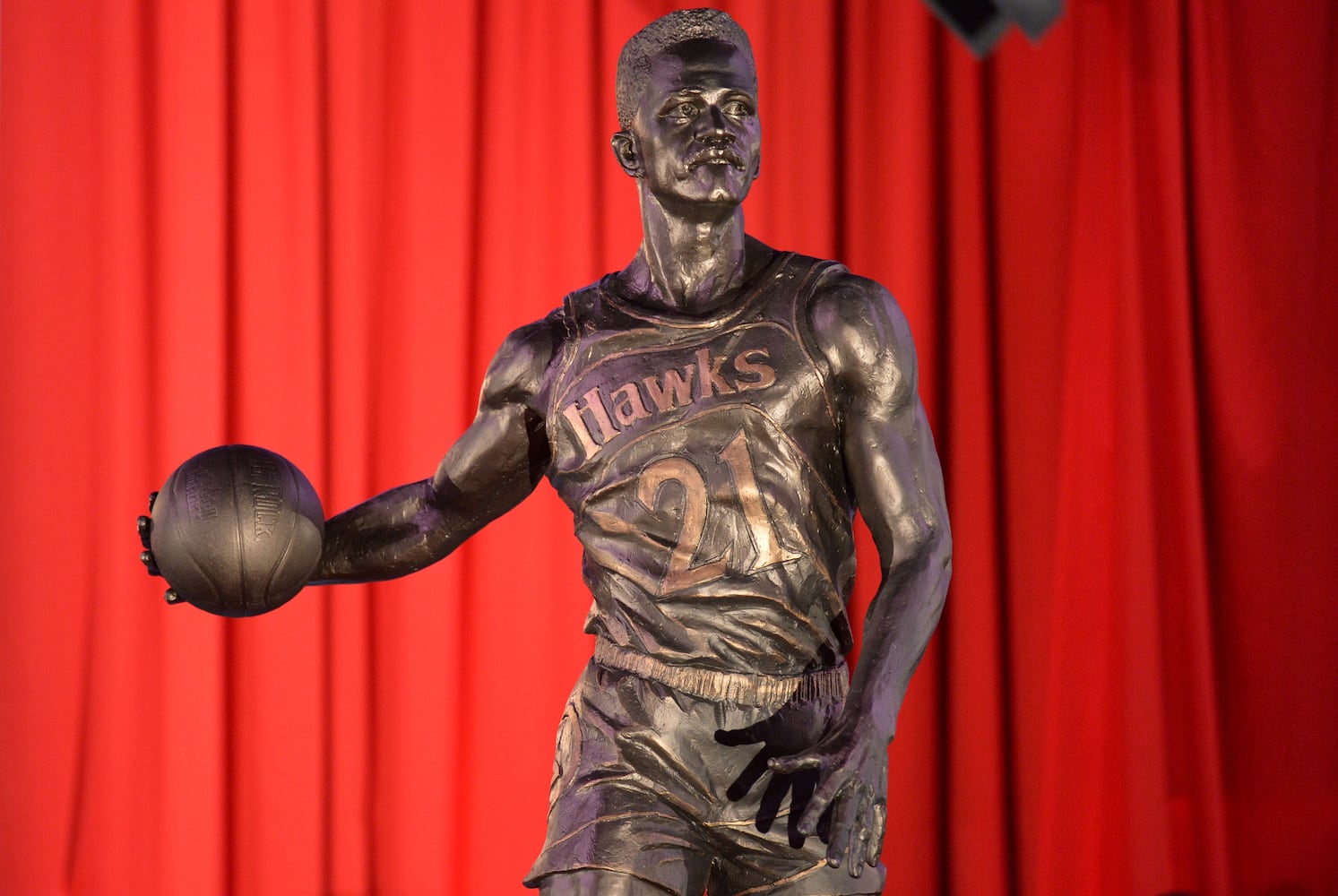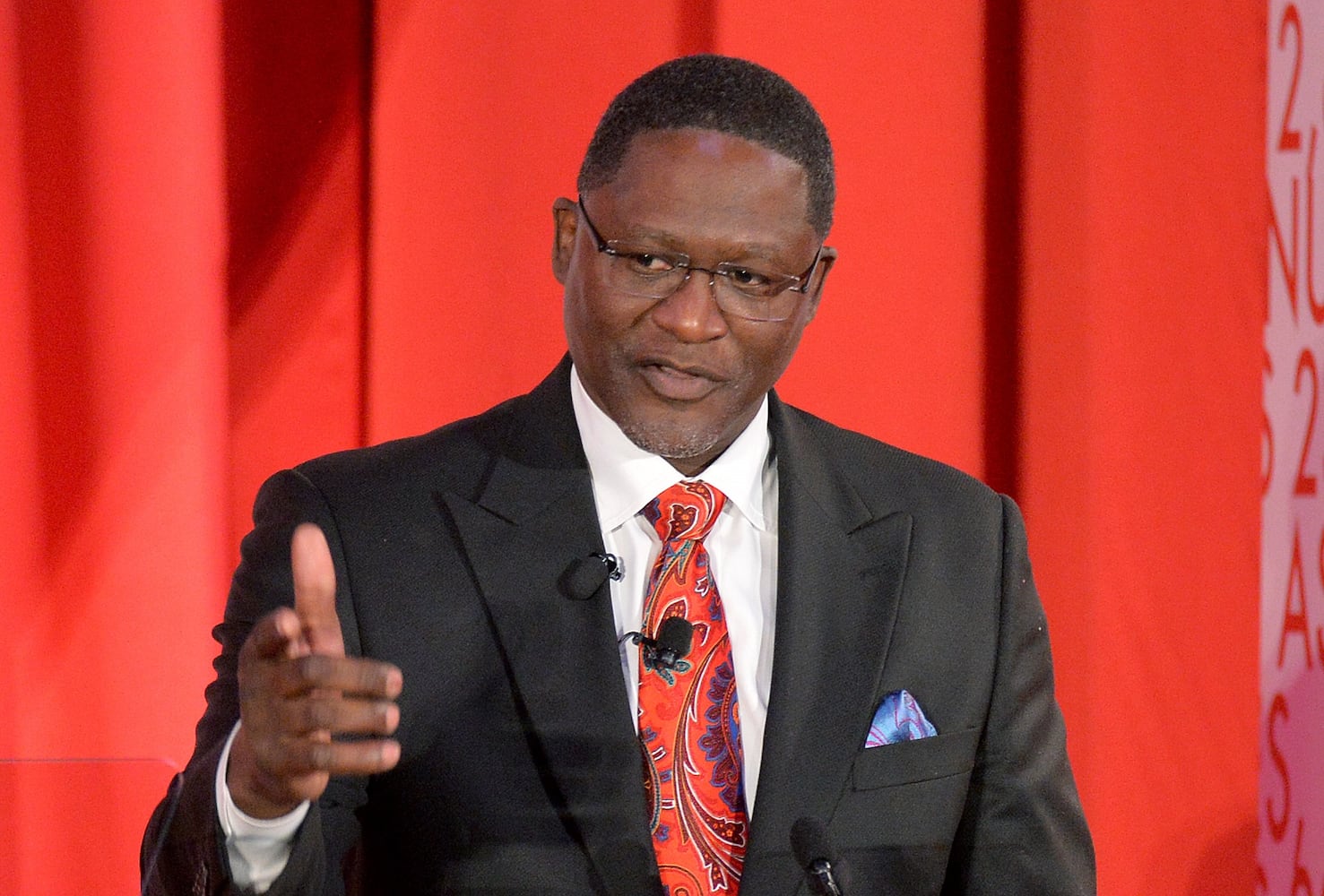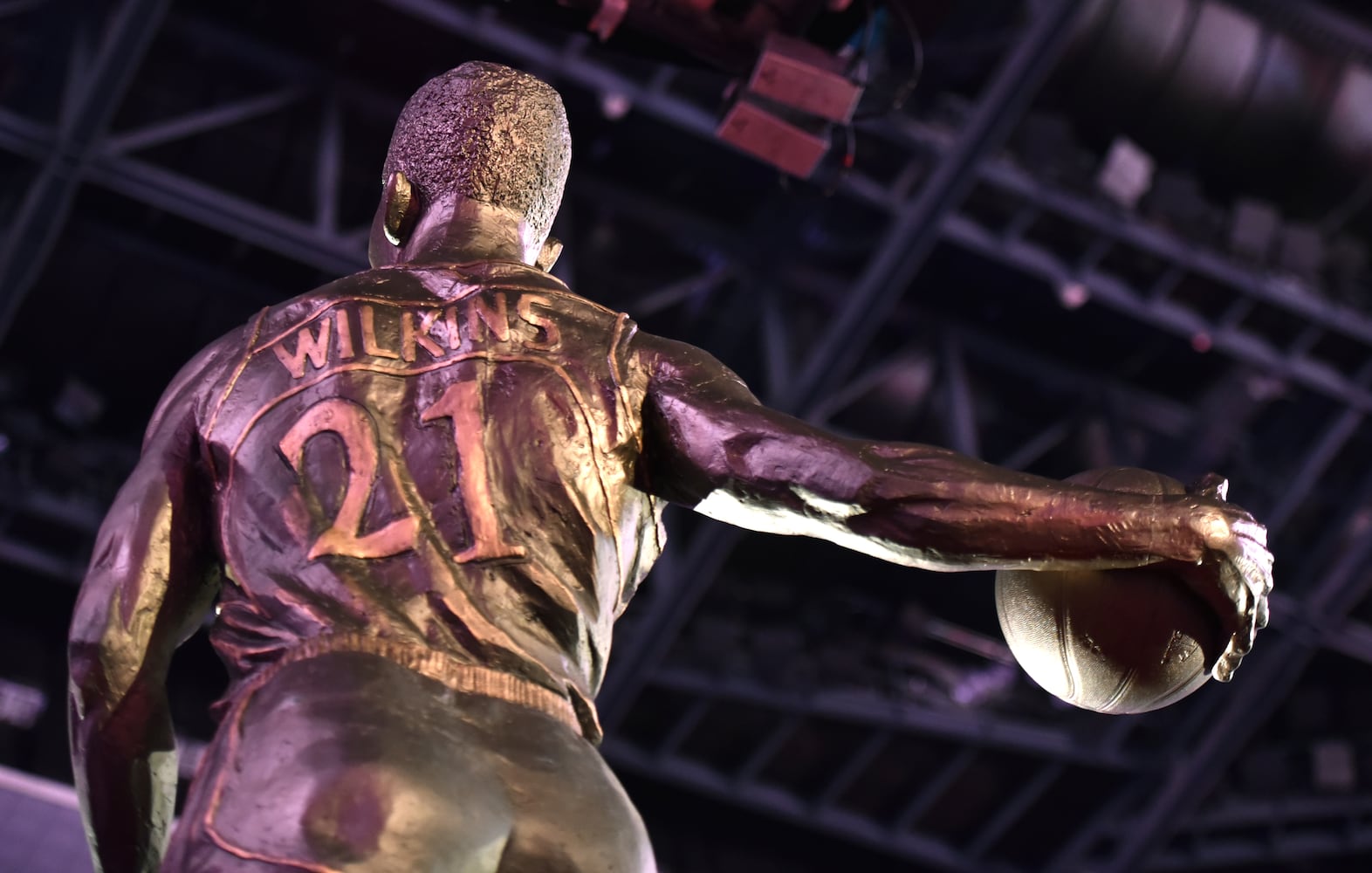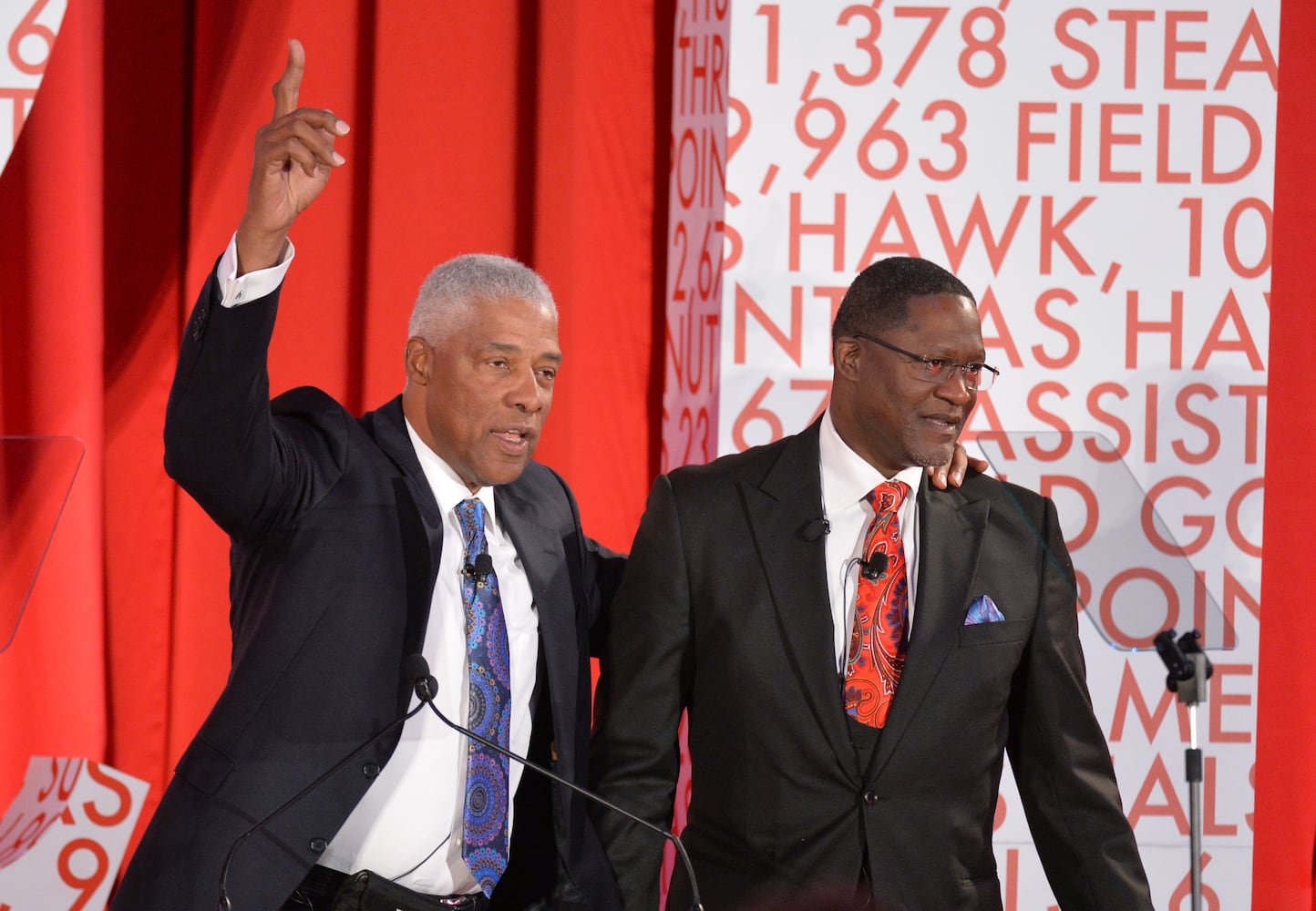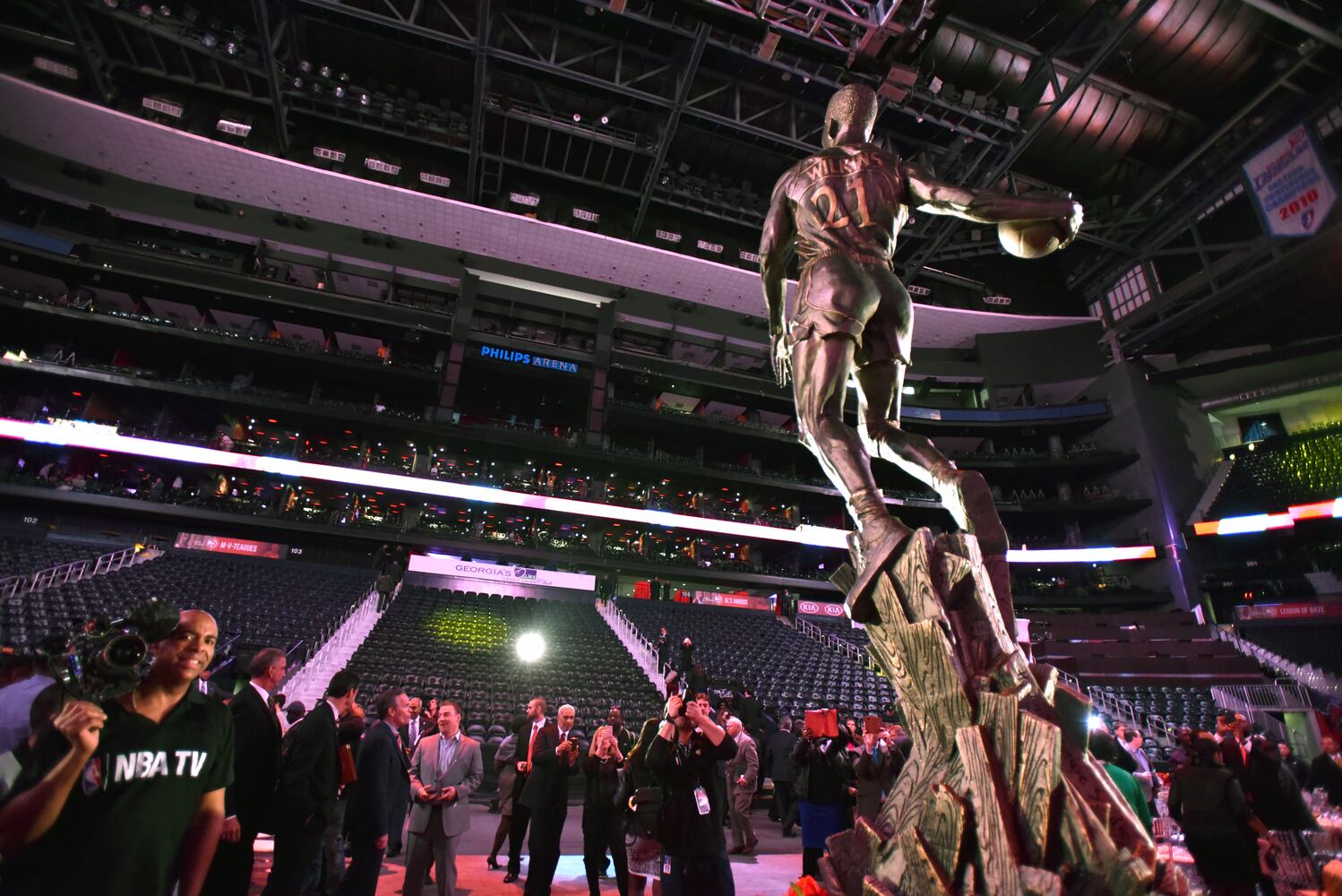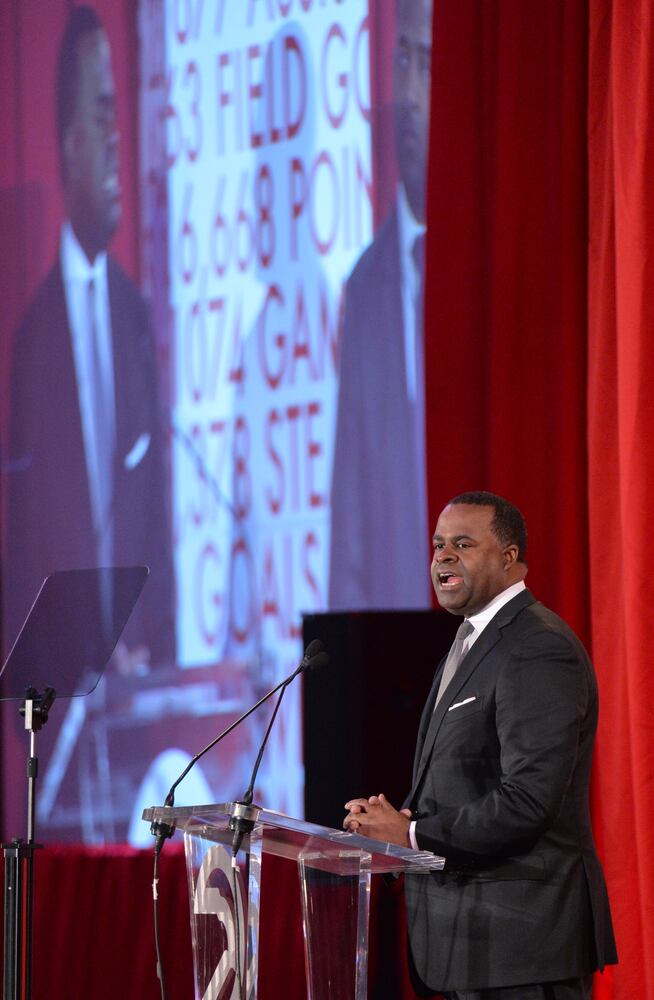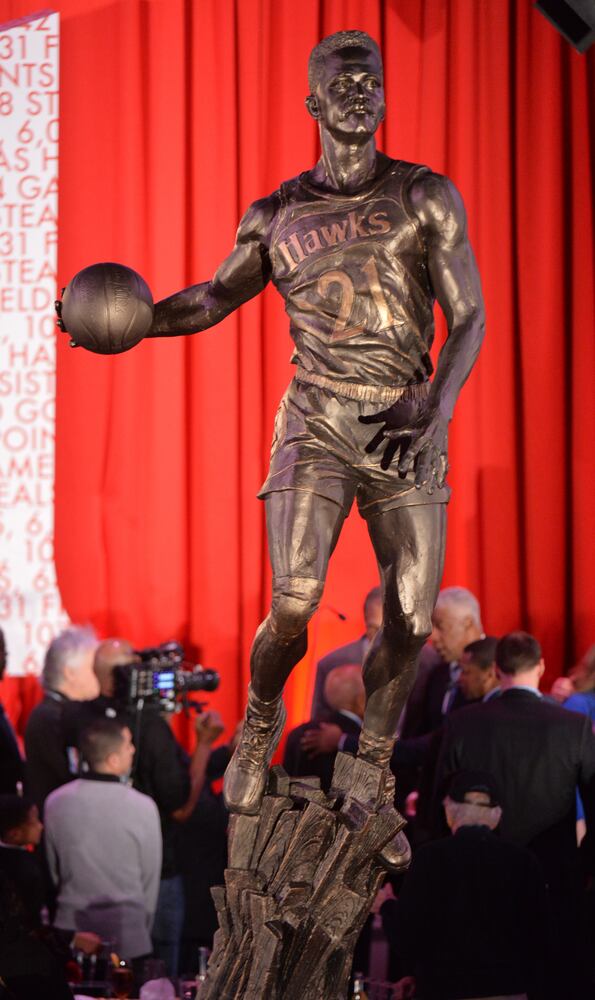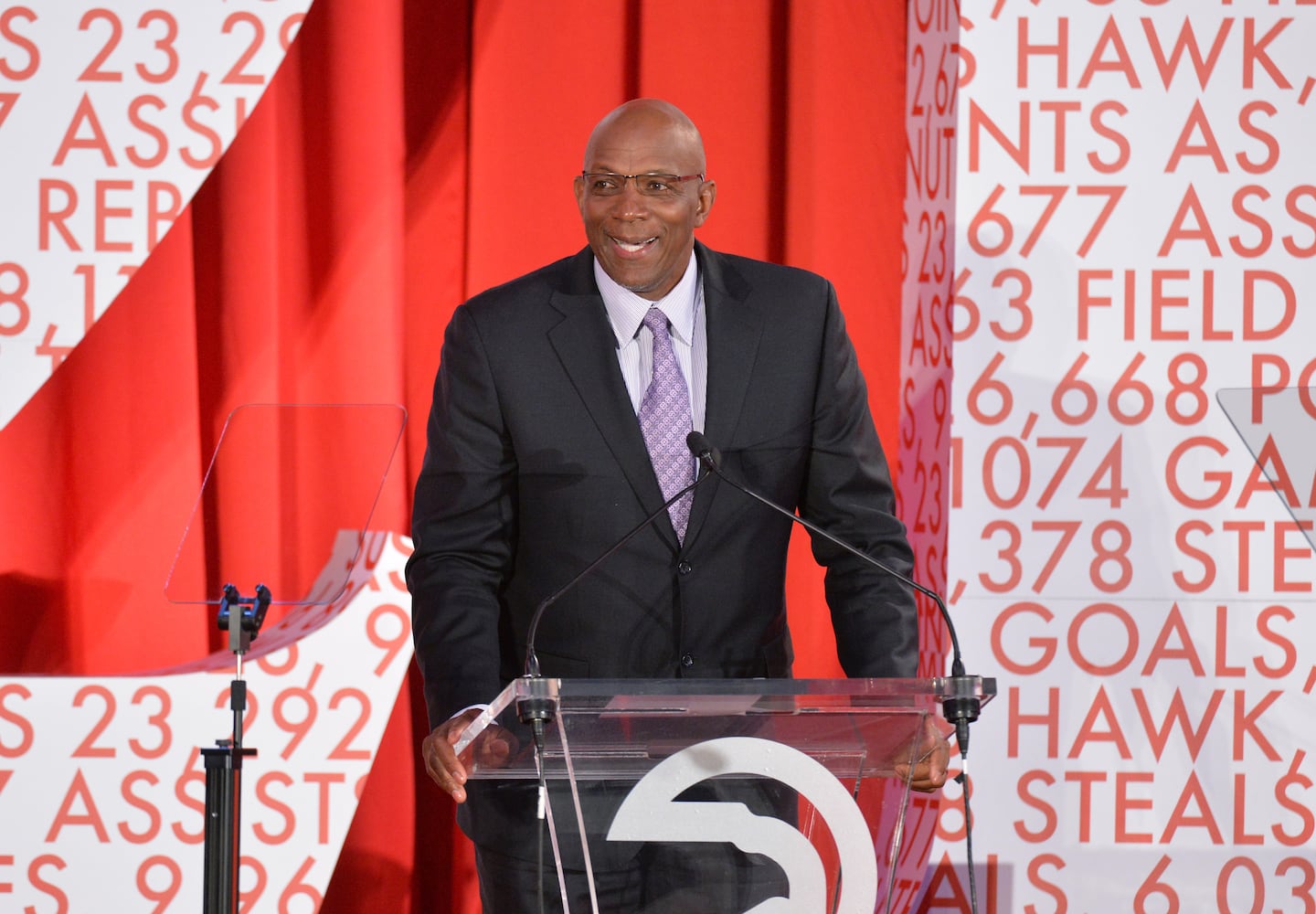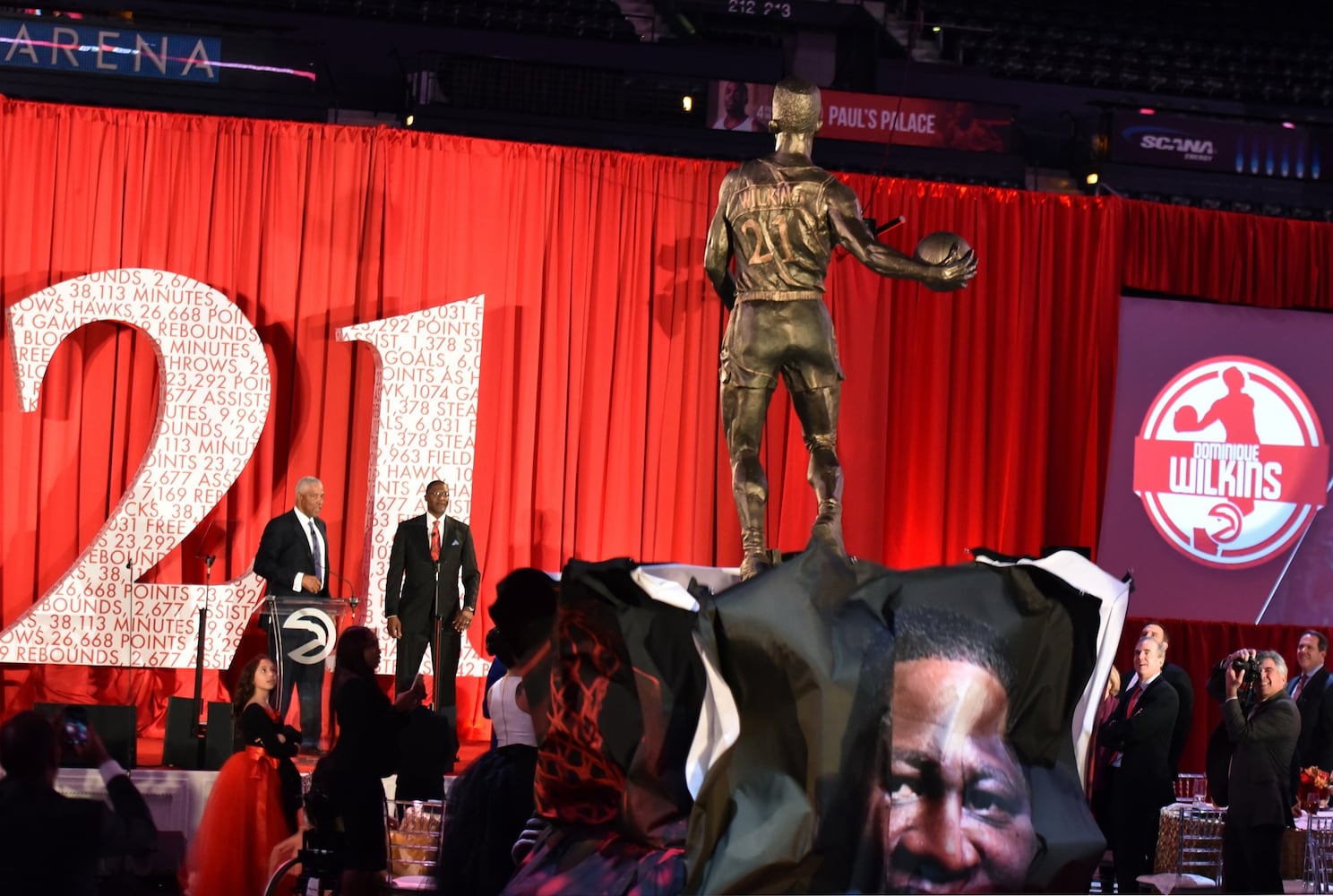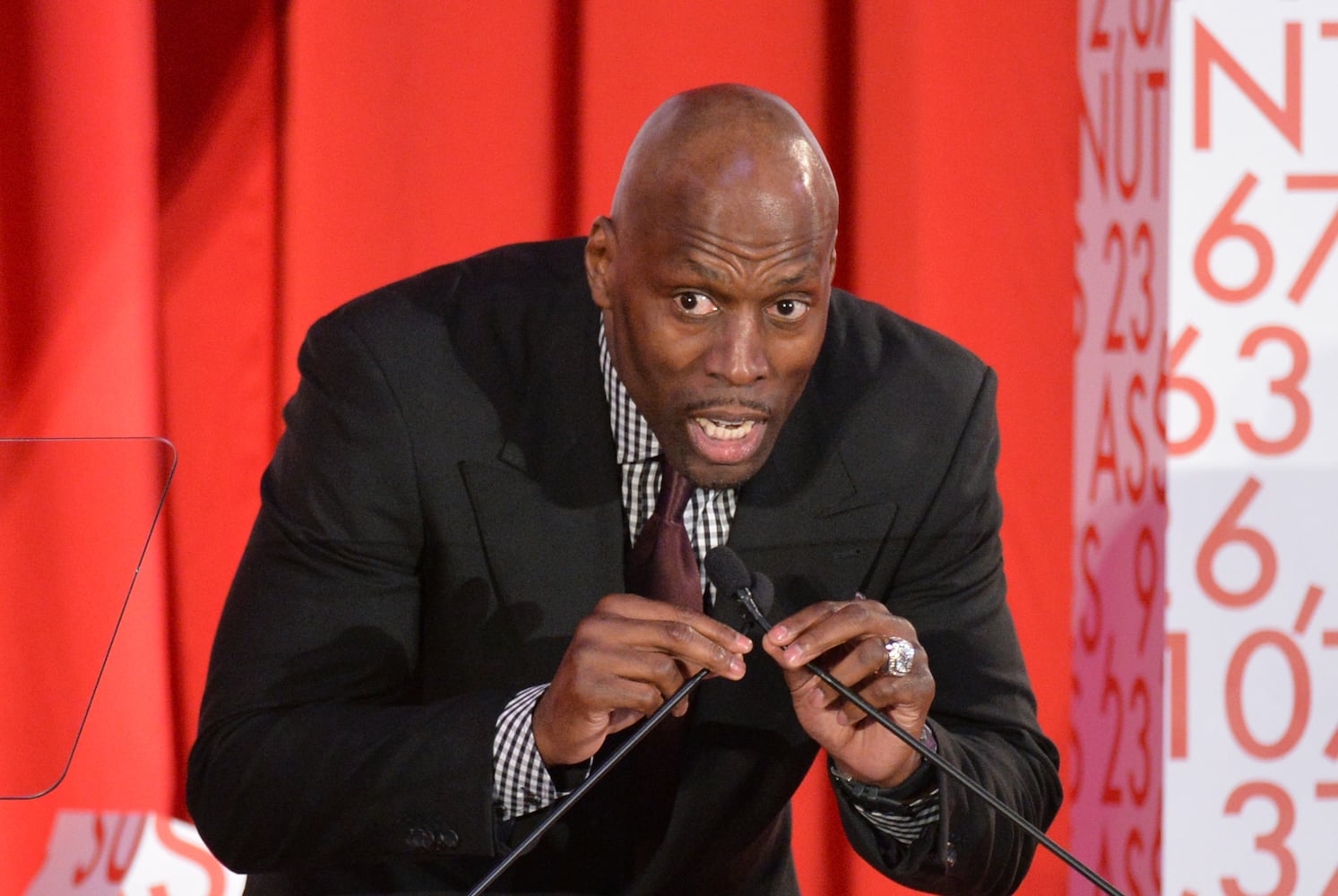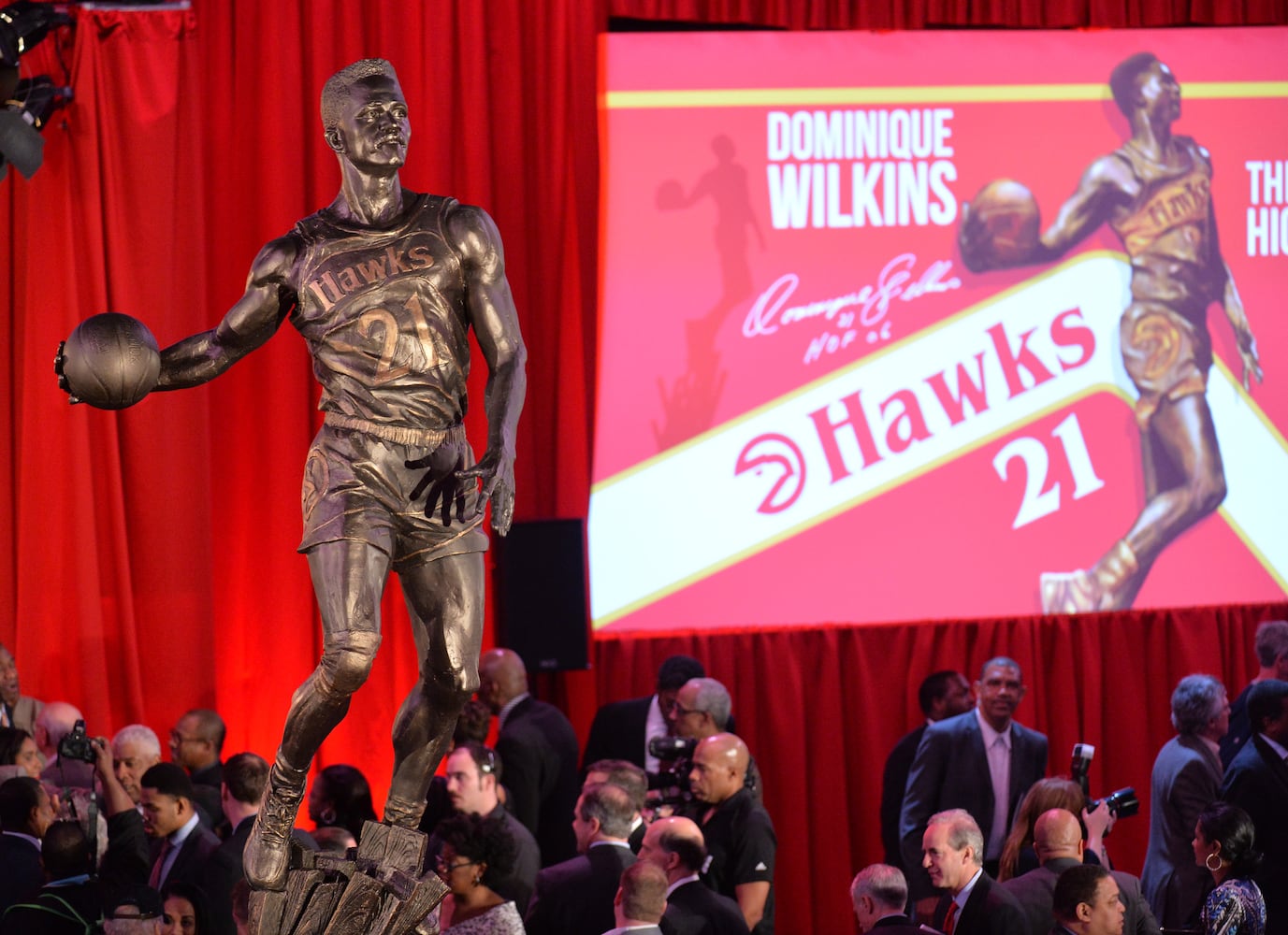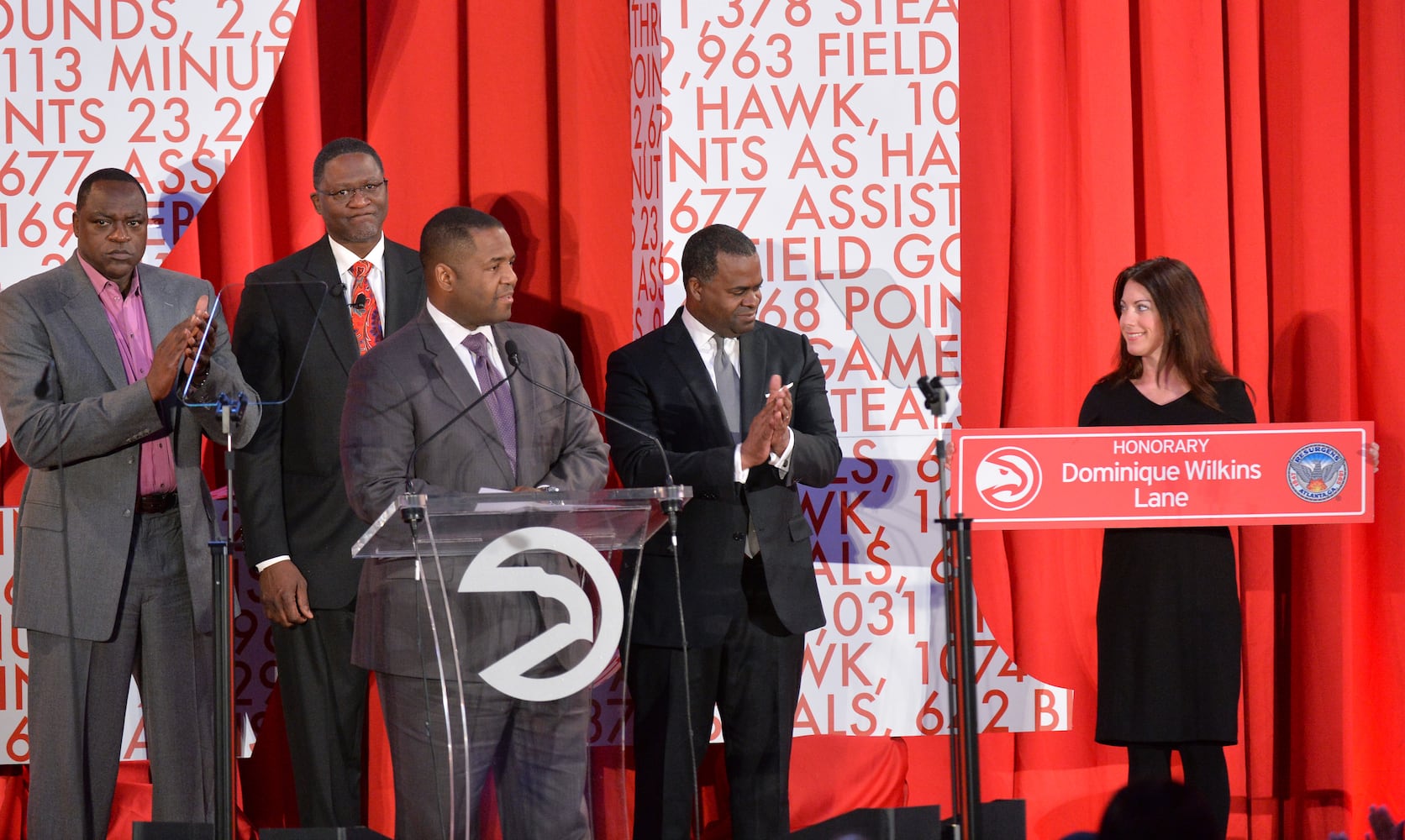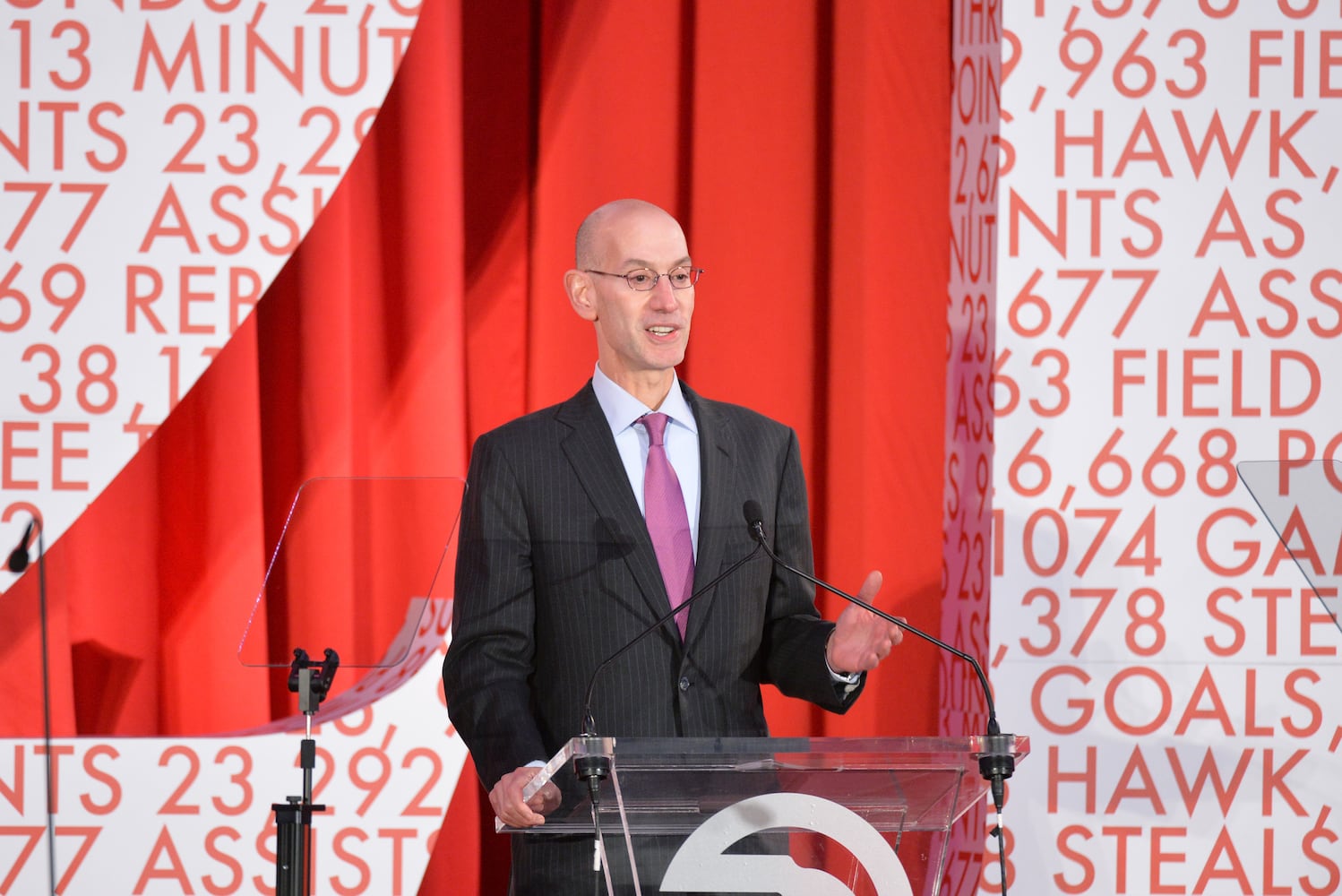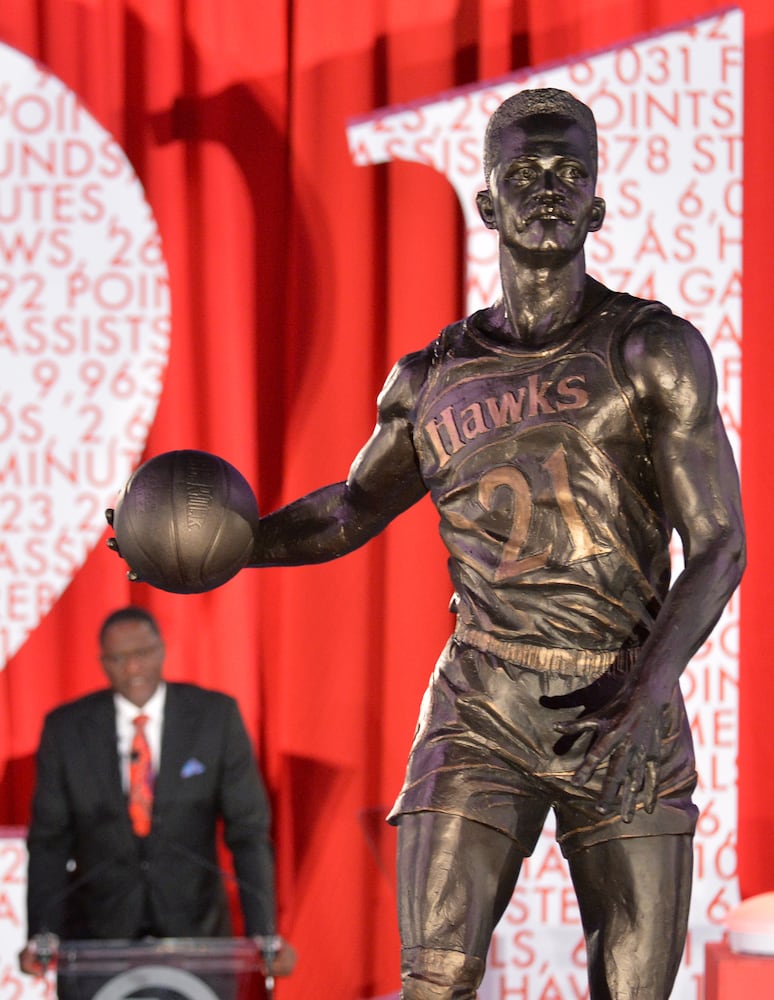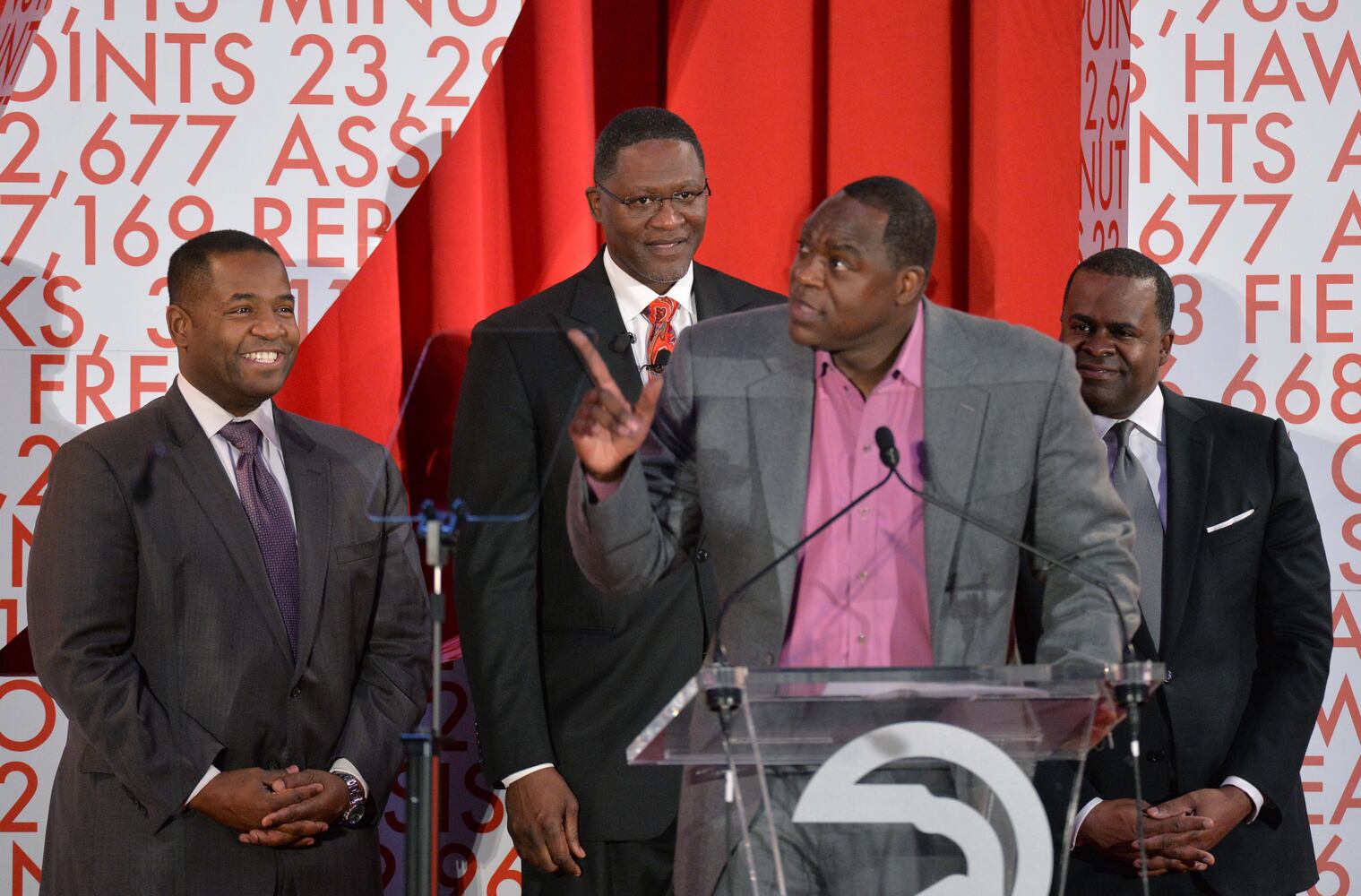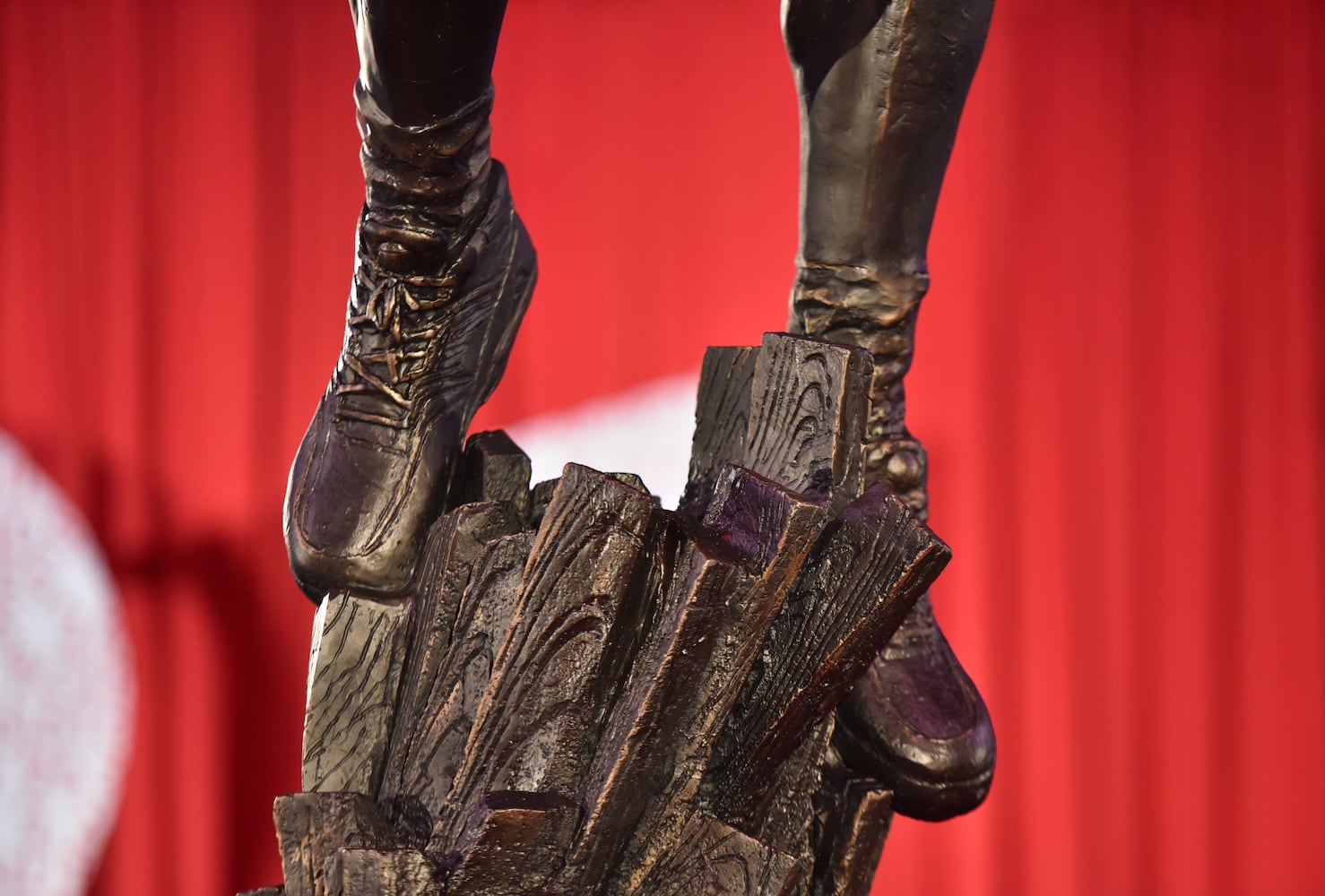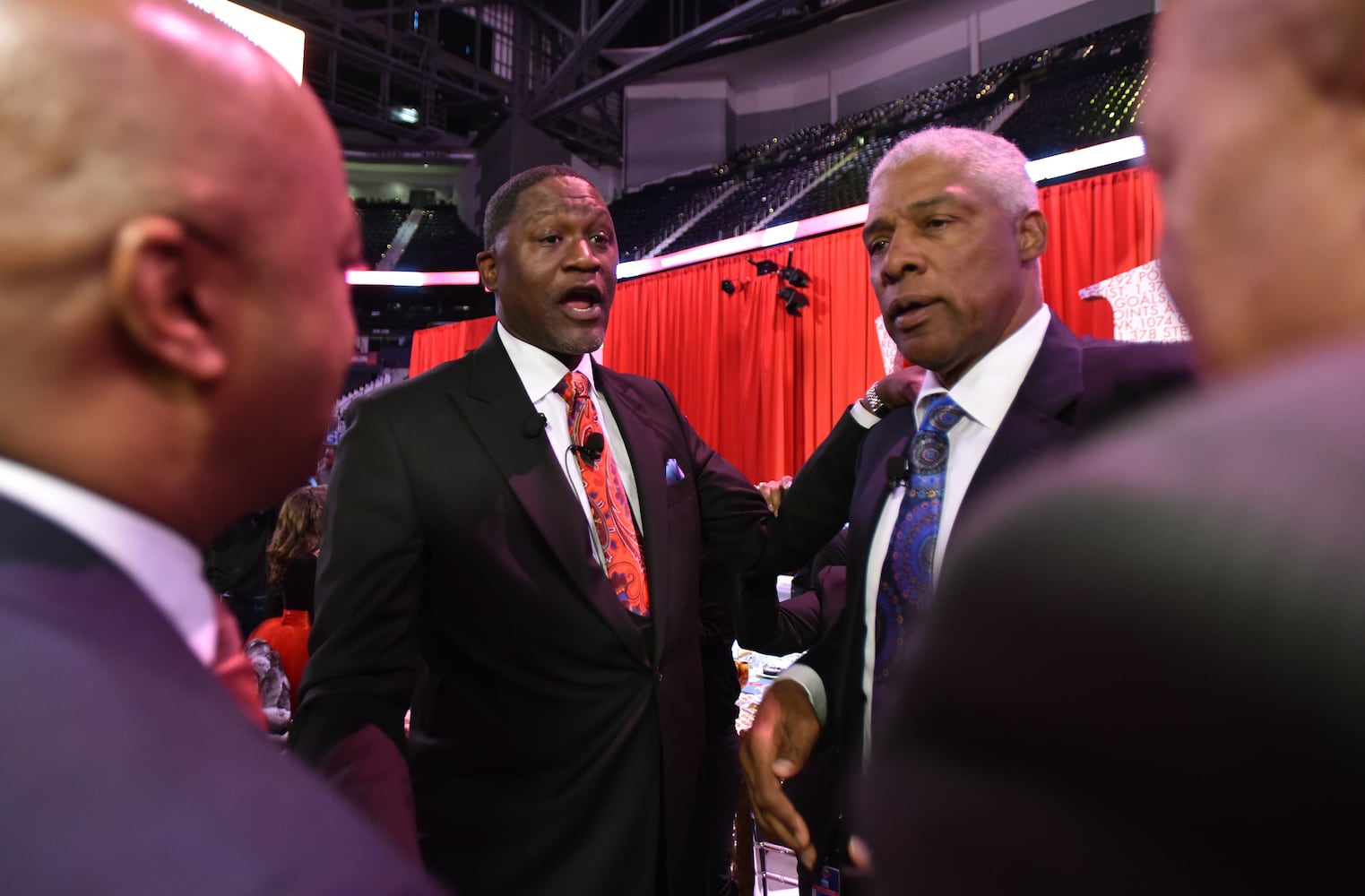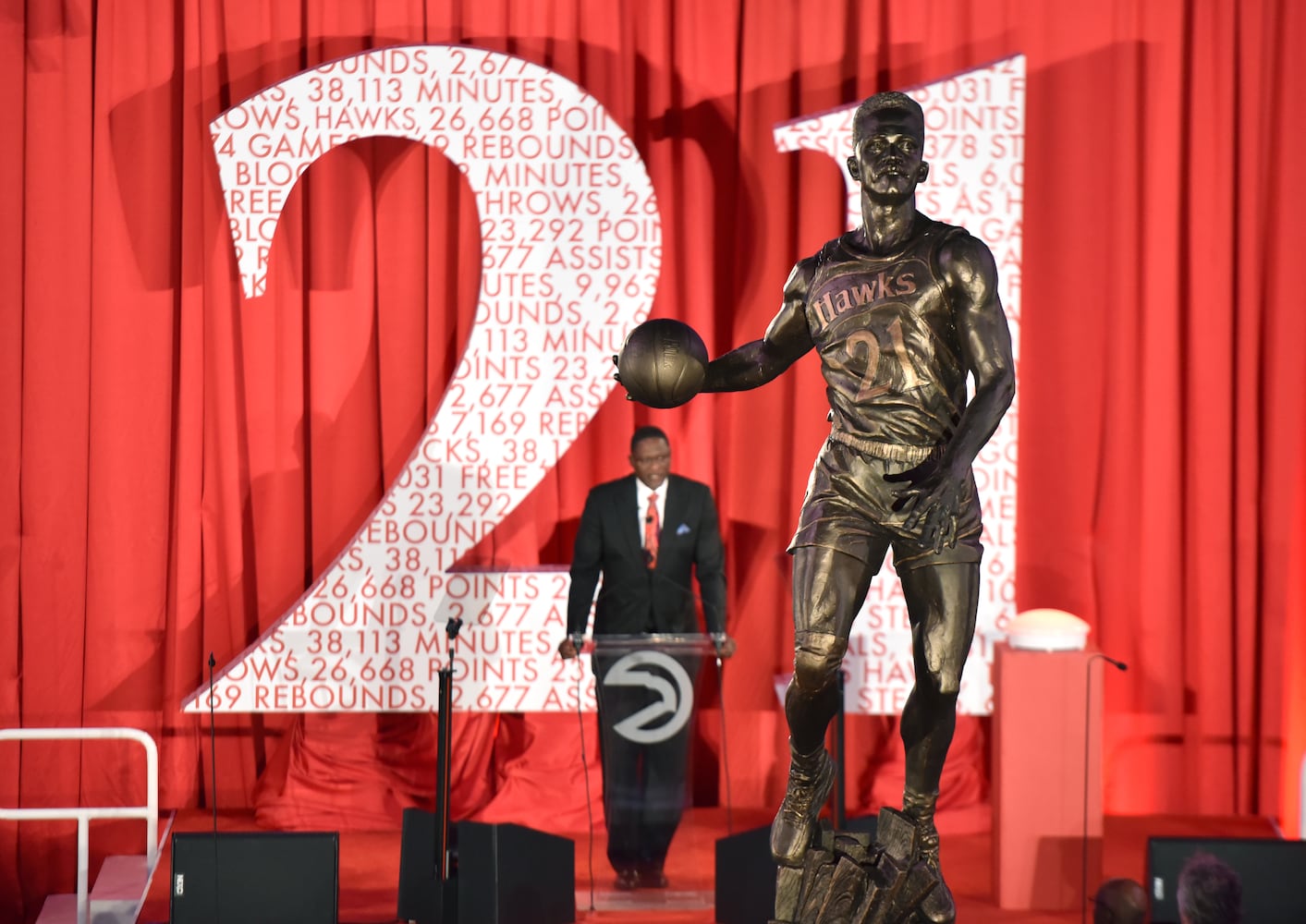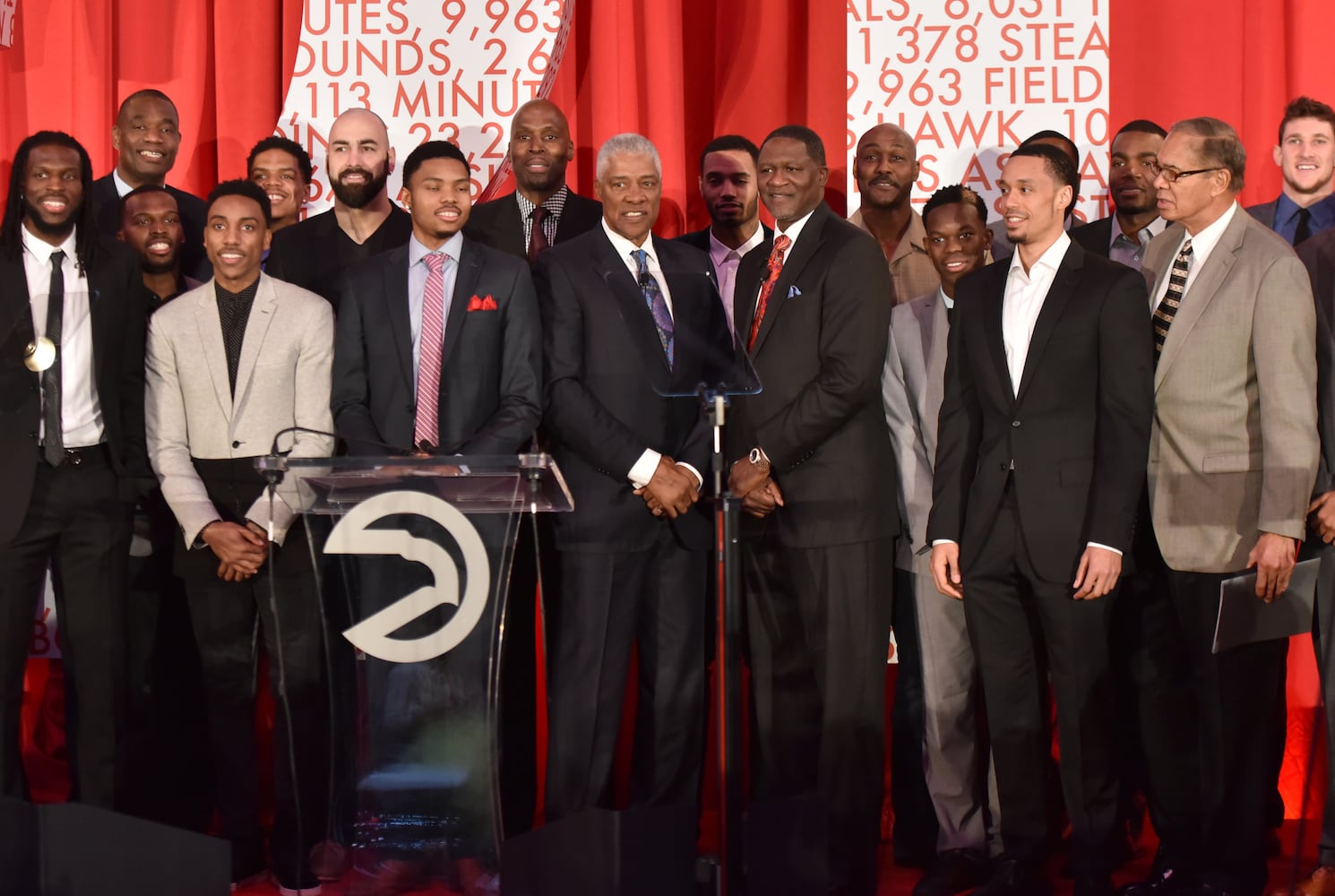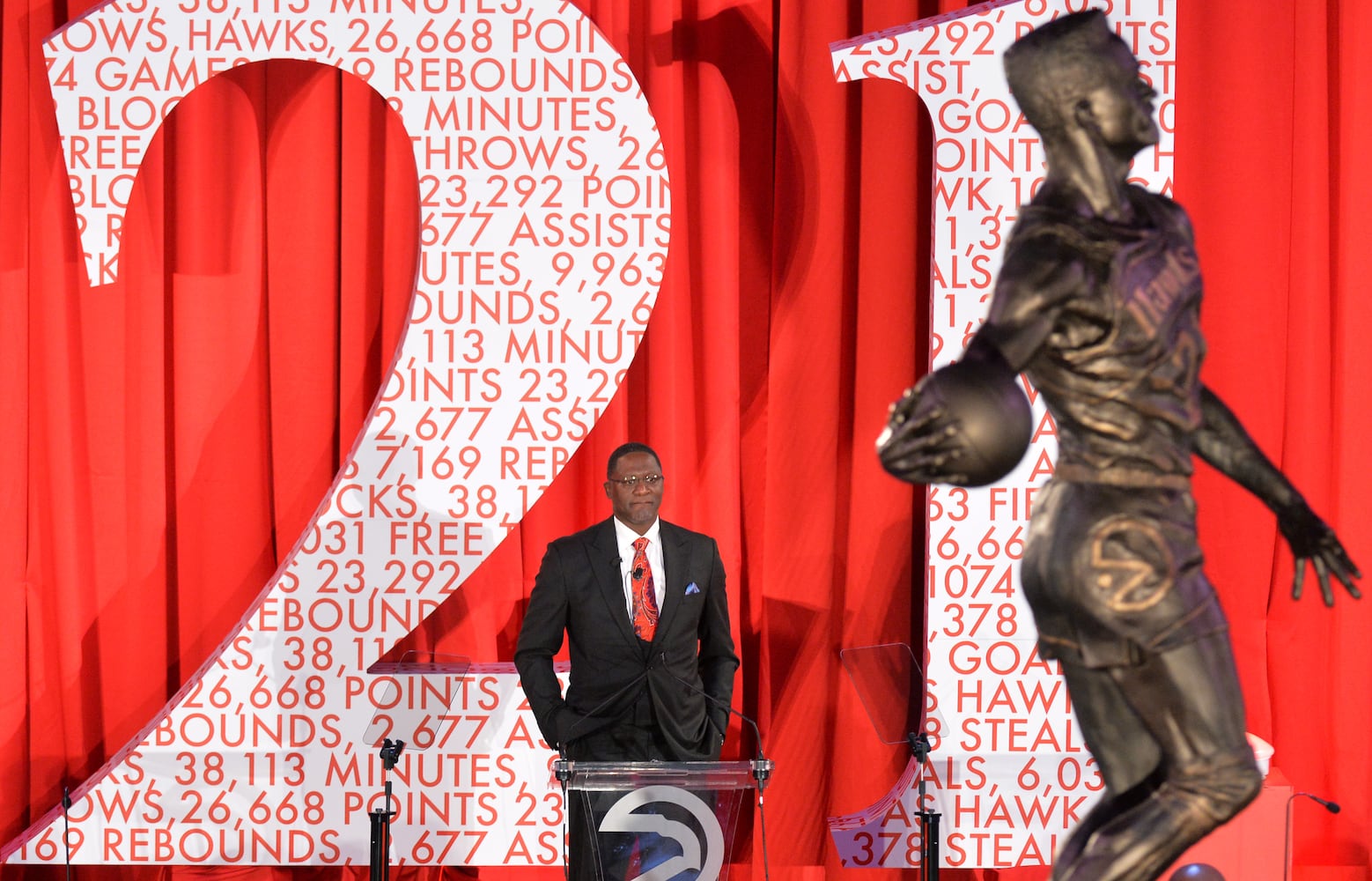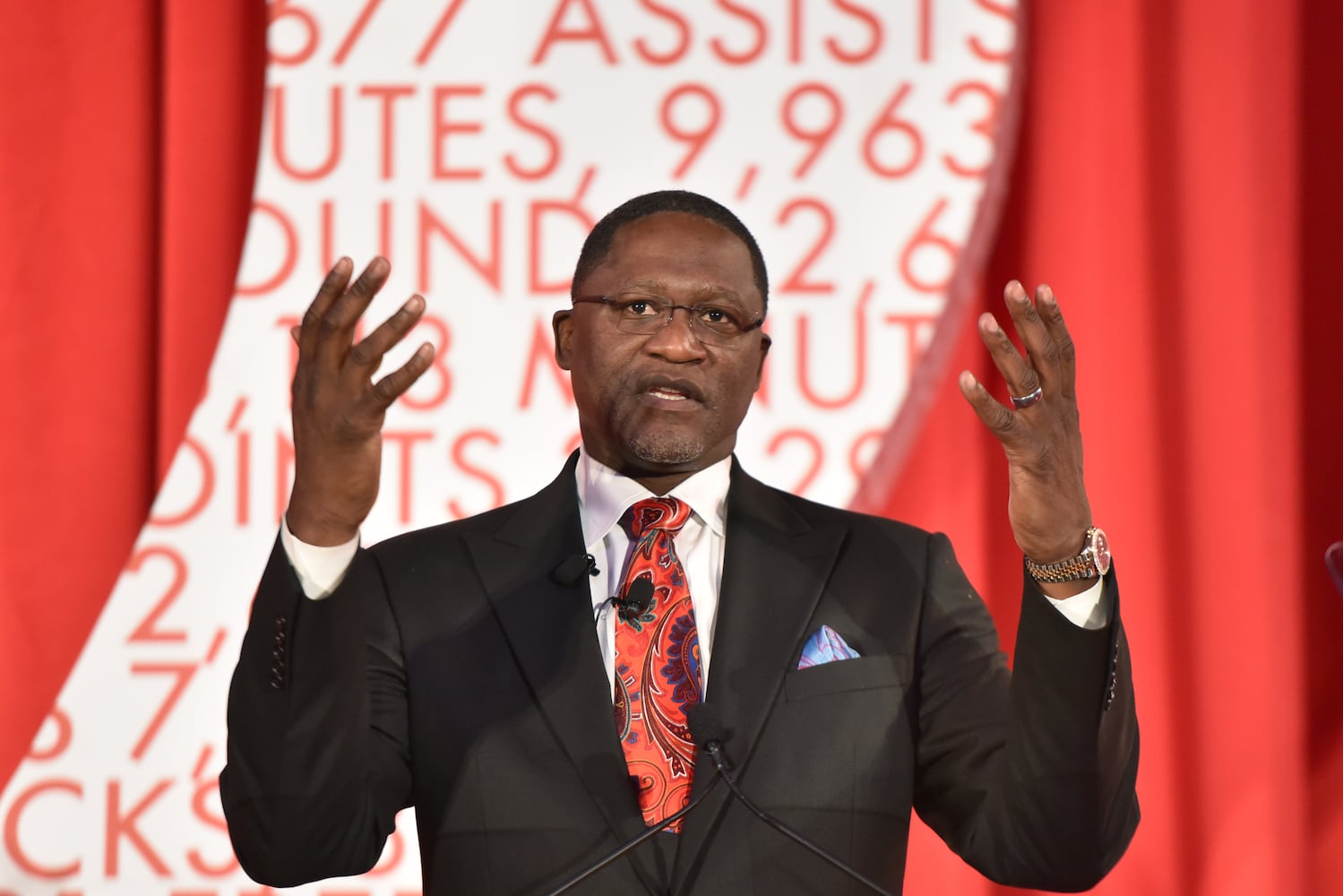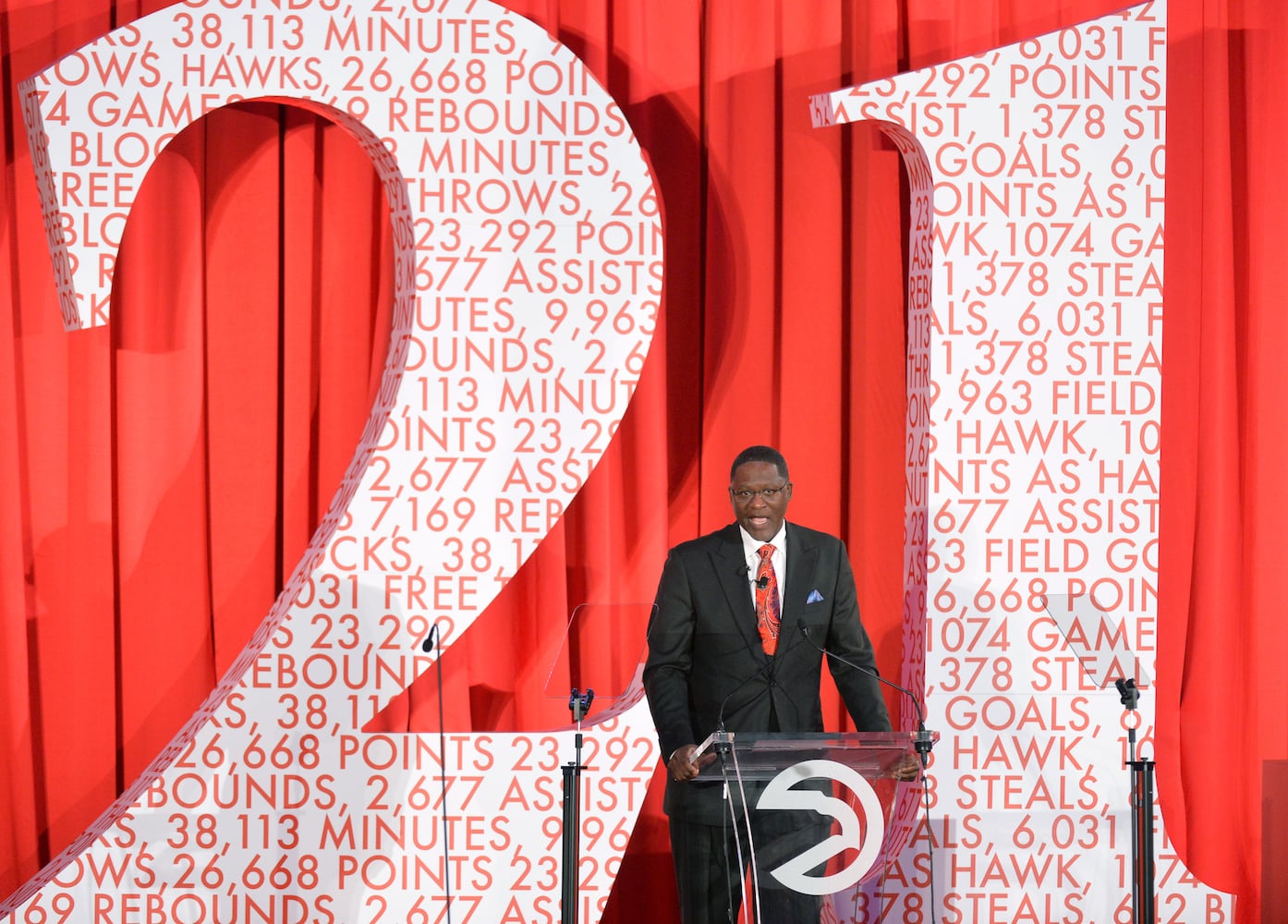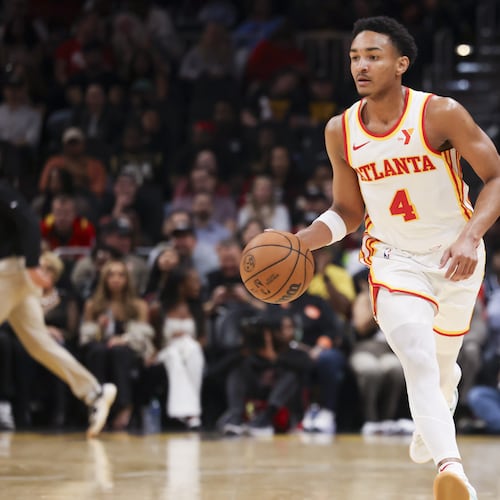His game was as much an American invention as those other miracles of flight like the airplane, the space shuttle and the Frisbee.
His name was borrowed from the French, as Jacques Dominique Wilkins was Paris-born while his father served abroad for the U.S. Air Force.
What an exotic mix, right down to his choice of clinging foremost to his middle name. “When I was younger, my mom and family used to call me Jacques, and I hated it,” Wilkins said.
“As I got older, I started to like Jacques, wondering why I didn’t use that name. I’m glad I didn’t. It made me unique in the league — the only Dominique.” (And certainly never to be confused for another former Hawk, Jacque Vaughn).
The one and only Dominique Wilkins is about to get permanently singular, set in granite and unveiled in the lavish manner of a civic hero outside an arena in which he never played. On Thursday night, nearly 21 years after he scored his 23,292nd and final point for the Hawks, the team officially commits to Wilkins in statuary.
“To be honest, I never thought it would happen,” Wilkins said.
Honor a long time coming
There is no fixed timetable for this sort of honor. Henry Aaron got his statue six years after he retired. Phil Niekro 10 years. In Los Angeles, Magic Johnson had an eight-year wait while Kareem Abdul-Jabbar was 23 years in the making. Michael Jordan got his while he was still playing.
“Never” looked like a reasonable over-under on the Wilkins project for the longest time.
Wilkins was the giver of instant gratification for 12 seasons inside the old Omni. “The Human Highlight film” even from his days as a Georgia Bulldog, he went from earthbound mortal to Olympian dunker in a muscle twitch. An opposing coach in New York once referred to him as “a human projectile.” Yet his statue was born of a long struggle against an embedded indifference to his legacy.
As Wilkins was enshrined in the Naismith Memorial Basketball Hall of Fame in 2006, the house sculptor, Brian Hanlon, sat in the audience in disbelief that there was no marker of the man back in Atlanta.
“I Googled it while I was sitting there, figuring maybe there was a bad statue of him somewhere that no one really knew about,” Hanlon said. “Nope. Nothing.”
Hanlon approached Wilkins during the Hall of Fame weekend and enthusiastically proclaimed he was going to do that statue and see to it that it found a proper home in Atlanta. He was flush with artistic fever.
But the enthusiasm was treated with the cold compress of apathy. “When I called the (Hawks) organization, there was dead silence. Nothing. No one was interested,” Hanlon said.
A confusing legacy
A thread of callous disregard runs all through the Wilkins story. There has been no small amount of confusion when trying to pin down the legacy of a player who was this franchise’s greatest star, but one who also never made it as far as a conference final. The only title Wilkins ever won was overseas (his Greek Panathinaikos team won the Euroleague in 1996).
Currently the NBA’s 12th all-time leading scorer (with 26,668 points), Wilkins was left off the NBA’s 50 Greatest Players list compiled in 1996.
The franchise that he carried for 11-plus seasons traded their leading scorer to the Los Angeles Clippers in the middle of the 1994 campaign — when the Hawks were leading their division and the Clippers were compiling the worst record in the West. In exchange, the Hawks rented Danny Manning for a fraction of a season, to no benefit whatsoever.
Wilkins’ role with the team in retirement has wavered at times, but now he holds a full quiver of titles: Broadcaster/vice president of basketball/special advisor to team CEO Steve Koonin.
All debate ends at what Wilkins meant to the Hawks teams of the 1980s and ’90s, the best of times until this season’s group came along.
“He would do at least one thing every night that would make you say, ‘Boy, I’m glad I was there to see that,’” said the team’s 30-year radio voice, Steve Holman.
“Dominique stood out as the guy who really put us on the map as far as basketball goes,” said Thomas Dortch, a longtime fan, businessman and community activist.
It was Dortch, a chief administrative assistant for Sen. Sam Nunn when he befriended Wilkins at his Hawks beginnings, who began trying to revive the statue idea nearly three years ago. There was money to raise (Dortch said this amounts to around a $350,000 project) and a franchise to convince — a sizable undertaking on both fronts.
The tumult that began this season with the racially charged remarks of Hawks controlling owner Bruce Levenson and GM Danny Ferry actually served as a final push to get the statue done. Seeking ways to reconnect with the community after that estrangement, the Hawks saw a tribute to Wilkins as a natural remedy.
Koonin threw his considerable energy behind the project. Minority members of the Atlanta Spirit ownership group Michael Gearon Jr. and Rutherford Seydel were supportive. And a new sporting landmark was born.
“This organization has been hurt enough, and now it’s a matter of what we do together to move forward and be above it,” Wilkins said.
“I’m always going to stand on the wall for this organization,” he said.
Well, yeah, literally in this case.
To be more precise, Wilkins will be standing upon a 4-foot granite base, in front of Philips Arena on Centennial Olympic Park Drive. He’ll be a little taller than you might remember — 13 1/2 feet — and whole lot heavier — nine tons, give or take a few hundred pounds.
Form of a competitor
Wilkins in statue form is frozen in the pose of possibility, ball cradled low as he is just lifting off for one of his windmill dunks. Beneath him, the boards of the court are exploding, unable to withstand the force of launch. The shorts are wickedly throw-back, tight and mid-thigh. In ’80s fashion, the haircut is perfectly planed.
Hanlon initially considered portraying Wilkins at the rim, finishing one of the backwards dunks that he flashed in the early NBA All Star dunk contests (winning in 1985 and ’90). “But after I got to know ’Nique,” he said, “I came up with this idea about the anticipation of the slam.”
There was more to Wilkins than the thunder of the jam. “I don’t think you can score almost 27,000 points all on dunks,” Holman said.
As Wilkins aged, and as he dealt with a ruptured Achilles (January 1992), he had to evolve. He tried to add little wrinkles to his game every season, and we’ll note here that 2,133 of those aforementioned points came from beyond the 3-point line.
Not that there was a shot anywhere on the court that he would decline. “I always used to kid Dominique that he’d rather pass a kidney stone than the basketball,” former Hawks coach Bob Weiss (1990-93) said.
An unrelenting competitor, Wilkins gave no quarter, not even to blood. Gerald Wilkins entered the NBA three years behind his big brother, during an era in which he matched up against the likes of Larry Bird, James Worthy and Julius Erving.
“And the hardest one to guard and the one who came at me the most was my brother,” Gerald said. “I knew then that my brother was never going to take it easy on me and there was no need for me to ever try to take it easy on him.”
Dominique is best known for an epic shootout with Boston’s Larry Bird during Game 7 of the 1988 Eastern Conference semifinals. Back and forth the two went, Wilkins scoring 47 (on 19-of-23 shooting) and Bird scoring 34. It speaks to the stubbornly incongruous nature of Wilkins’ legend that his shining moment was framed by a crushing 118-116 loss.
Win or lose, it was nearly impossible to pry him out of the lineup, no matter how the seasons ground on. It required something drastic, a ruptured Achilles, to rob him of significant playing time.
“Dominique was of that old school that knew no matter where we were — Atlanta or on the road — people had bought tickets to see him play,” Holman said. “He would take that to heart, as an entertainer, not just a basketball player. He felt an obligation to play every night.”
“He would come out every night and put up numbers that were just unbelievable,” said Kevin Willis, a former Hawks teammate. “No one could do it better than him if you were talking about dunking a basketball or coming out with this fire and determination to let people know that he wasn’t just passing through, he was here to make a huge impact on the NBA.”
Certainly, there was more that put the ’Nique in unique than just the dunk. Ah, but that ultimate expression of basketball might, re-introduced to the NCAA only three years before Wilkins’ arrival at UGA, that staple of the “SportsCenter” highlight package is destined forever to be his signature.
Wilkins horizontal jumping was well-established from his childhood days in Baltimore by leaping from rooftop to rooftop, easily clearing the city’s narrow alleyways. His vertical already was of note by the age of 14, when he could dunk a volleyball on a playground rim hanging considerably higher than the 10-foot regulation. And he could always hustle a dollar here and there from any disbeliever.
In his own words
What Wilkins could have no idea of knowing was that one day one of Gertrude Baker’s eight children was going to have that talent committed to everlasting granite.
“Even the 50 greatest don’t all have statues,” brother Gerald said, bringing up that sore point of Dominique’s exclusion from the NBA’s all-time list.
“What this statue does is connect me to the history of this city,” Wilkins said.
And how would he like that history to read? What should those who pass by a certain soaring stone likeness read into it — even as the years pass and fewer and fewer of them will have ever remembered seeing Jacques Dominique Wilkins play?
Here’s his own lengthy inscription:
“I want people to think of how much I love the game, how hard I played the game. I never believed in quitting.
“I want people to see that, see a guy who put everything on the line for his teammates and the people in the city.
“I want them to see the start of the history of our franchise.
“I want young kids to say, hey, if I work hard enough I may one day do something great.”
About the Author
Keep Reading
The Latest
Featured

